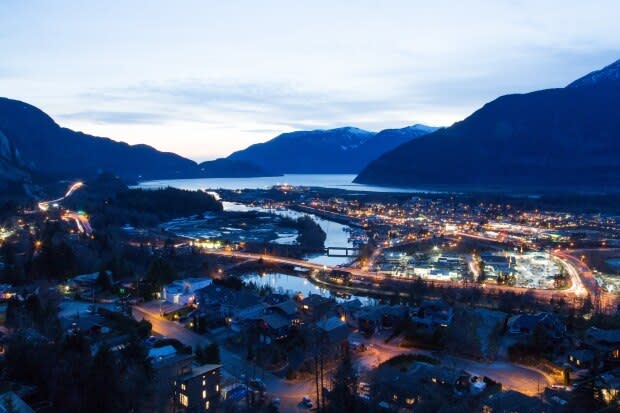Upgraded Sea-to-Sky Highway improved safety but brought 'big city problems' says mayor

Bruce McArthur spent his childhood frolicking in the West Vancouver woodlands known as the Eagleridge Bluffs.
So when a major infrastructure project ahead of the Vancouver 2010 Olympics threatened to bulldoze part of the beloved forest, he was among the first to take a stand.
"There was a proposal to upgrade the highway to get to Whistler," said McArthur, 82, who was among the members of the Coalition to Save Eagleridge Bluffs. "I gathered all sorts of information, brought it to our membership ... and we decided it wasn't the best option."
The Sea-to-Sky Highway project was met with protests from environmental activists and residents of the North Shore, largely because part of the proposed expansion would plow through sensitive ecosystems.

There were large demonstrations, court injunctions, and even arrests, but the upgrades eventually went through. Those at the forefront of the fight have mostly moved on, some even commending the job that was done.
But the finished product has opened the door for a host of new challenges, like increased traffic — and swelling costs of living in communities along the highway.
"It made communities like Squamish near to Vancouver," said former B.C. Liberal cabinet minister Kevin Falcon. "A lot of people are now living and commuting back and forth along the corridor. That was not a realistic option under the old highway."
Necessary upgrades
Prior to its expansion, the Sea-to-Sky Highway was known for its hazards. The bulk of it was two lanes, undivided and without no outside barrier.
"That was the most dangerous sections of highway in British Columbia, where terrible tragedies, injuries, deaths occurred," said Falcon.
In the mid-2000s, Falcon was B.C.'s transportation minister tasked with overseeing upgrades to the highway as part of its 2010 Olympic Bid.
"We had a major rockslide just a few years prior to the Olympics that got international attention," he said. "It was unsafe, it was a very narrow road .... the Olympics just gave us a reason to accellerate what needed to be done."

The project ended up costing upwards of $600 million, but a major point of contention was the Eagleridge Bluffs area of the corridor, now the site of the Nelson Creek Bridge.
Residents rallied against construction plans, which they said would destroy sensitive habitat to native species including the red-tailed frog. Former West Vancouver mayor Pamela Goldsmith-Jones was among those calling for the province to build a tunnel rather than cutting through the wetland.
Protests blockaded construction, but a court eventually ruled against them and ordered them to leave. Indigenous rights activist Harriet Nahanee, and environmentalist Betty Krawczyk were arrested for violating the court injunction. Krawczyk was subsequently sentenced to ten months in prison.
Watch: the highway is safer, but that's brought new challenges to Squamish
New problems
Shortly after the upgrades were complete, the highway enjoyed a significant drop in crashes. Between 1998 and 2007, 63 people died on the Sea-to-Sky Highway. There were upwards of 200 crashes per year. But by 2010, after the upgrades were complete, the number of crashes dropped by 66 per cent.
Communities along the corridor have grown significantly in the years since — Squamish and Whistler are among the fastest growing cities in B.C. According to the Ministry of Transportation, more than 19,000 commuters drive the Sea to Sky highway each day — up 24 per cent over a decade.
According to Squamish's recently passed Official Community Plan, the district could double in the next 20 years.
Mayor Karen Elliott says the renewed highway has made her community a far more attractive living option for people who work in Metro Vancouver.

"It's brought some big city problems that with grappling with for our community," she said. "The cost of housing, it went up very quickly. Our vacancy rate has been near zero since 2015."
The streets of Squamish are lined with new developments, with many more in the pipeline. The municipality is currently working toward an affordable housing plan to in part address the issue. The benchmark price for a single-family home in the community has risen to about $1 million.
Elliott says traffic has also become a big issue.
"Probably about 25 per cent of our population is going north or south on the highway right now," added "Now we see that highway with the tourism traffic and commuters, on busy weekends — it starts to fail."
She's hoping to see improved regional transit to help address some of the congestion.
"We're working with the mayors in the corridor and the Squamish-Lillooet Regional District, and we're working with the province on a funding model that will work for regional transit," said Elliot.
A bittersweet legacy
For those looking back, they admit there were some positive changes. Pamela Goldsmith-Jones says West Vancouver adopted a more eco-friendly approach when it comes to approving new developments following the Sea-to-Sky Highway upgrades.
"Now, through processes that we put in place, the streams come first, the trees come first, and development will try to put on as small of a footprint as possible," she said.

Meanwhile protesters like McArthur say have no regrets over their demonstrations and court challenges. After raising concerns to the province, he says contractors were able to preserve a swath of wetland near White Lake.
Crews even installed passageways onto the road for frogs to cross through.
"I'm pretty convinced because we did make a stance that we got a better job than we would have if we just were quiet," he said. "It appears that they were more sensitive to the environment because we spoke out."
"[But] it still bothers me to look at all the concrete and asphalt," he added.


